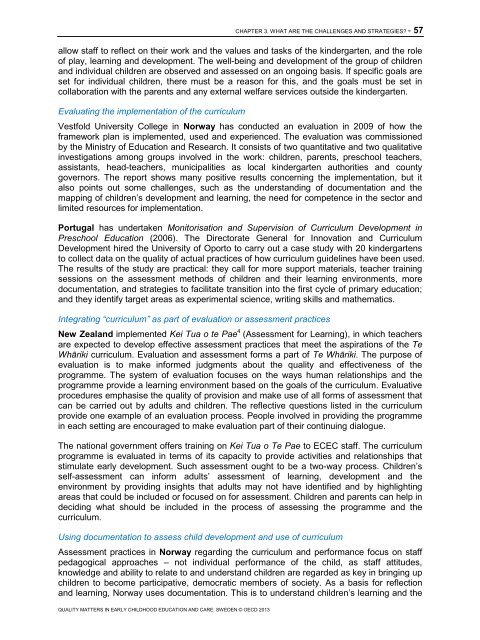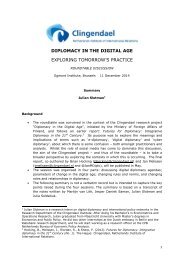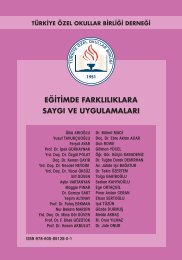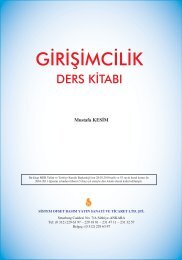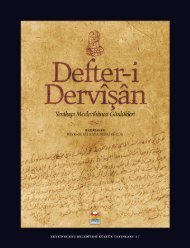SWEDEN%20policy%20profile%20-%20published%2005-02-2013
SWEDEN%20policy%20profile%20-%20published%2005-02-2013
SWEDEN%20policy%20profile%20-%20published%2005-02-2013
You also want an ePaper? Increase the reach of your titles
YUMPU automatically turns print PDFs into web optimized ePapers that Google loves.
QUALITY MATTERS IN EARLY CHILDHOOD EDUCATION AND CARE: SWEDEN © OECD <strong>2013</strong><br />
CHAPTER 3. WHAT ARE THE CHALLENGES AND STRATEGIES? - 57<br />
allow staff to reflect on their work and the values and tasks of the kindergarten, and the role<br />
of play, learning and development. The well-being and development of the group of children<br />
and individual children are observed and assessed on an ongoing basis. If specific goals are<br />
set for individual children, there must be a reason for this, and the goals must be set in<br />
collaboration with the parents and any external welfare services outside the kindergarten.<br />
Evaluating the implementation of the curriculum<br />
Vestfold University College in Norway has conducted an evaluation in 2009 of how the<br />
framework plan is implemented, used and experienced. The evaluation was commissioned<br />
by the Ministry of Education and Research. It consists of two quantitative and two qualitative<br />
investigations among groups involved in the work: children, parents, preschool teachers,<br />
assistants, head-teachers, municipalities as local kindergarten authorities and county<br />
governors. The report shows many positive results concerning the implementation, but it<br />
also points out some challenges, such as the understanding of documentation and the<br />
mapping of children’s development and learning, the need for competence in the sector and<br />
limited resources for implementation.<br />
Portugal has undertaken Monitorisation and Supervision of Curriculum Development in<br />
Preschool Education (2006). The Directorate General for Innovation and Curriculum<br />
Development hired the University of Oporto to carry out a case study with 20 kindergartens<br />
to collect data on the quality of actual practices of how curriculum guidelines have been used.<br />
The results of the study are practical: they call for more support materials, teacher training<br />
sessions on the assessment methods of children and their learning environments, more<br />
documentation, and strategies to facilitate transition into the first cycle of primary education;<br />
and they identify target areas as experimental science, writing skills and mathematics.<br />
Integrating “curriculum” as part of evaluation or assessment practices<br />
New Zealand implemented Kei Tua o te Pae 4 (Assessment for Learning), in which teachers<br />
are expected to develop effective assessment practices that meet the aspirations of the Te<br />
Whāriki curriculum. Evaluation and assessment forms a part of Te Whāriki. The purpose of<br />
evaluation is to make informed judgments about the quality and effectiveness of the<br />
programme. The system of evaluation focuses on the ways human relationships and the<br />
programme provide a learning environment based on the goals of the curriculum. Evaluative<br />
procedures emphasise the quality of provision and make use of all forms of assessment that<br />
can be carried out by adults and children. The reflective questions listed in the curriculum<br />
provide one example of an evaluation process. People involved in providing the programme<br />
in each setting are encouraged to make evaluation part of their continuing dialogue.<br />
The national government offers training on Kei Tua o Te Pae to ECEC staff. The curriculum<br />
programme is evaluated in terms of its capacity to provide activities and relationships that<br />
stimulate early development. Such assessment ought to be a two-way process. Children’s<br />
self-assessment can inform adults’ assessment of learning, development and the<br />
environment by providing insights that adults may not have identified and by highlighting<br />
areas that could be included or focused on for assessment. Children and parents can help in<br />
deciding what should be included in the process of assessing the programme and the<br />
curriculum.<br />
Using documentation to assess child development and use of curriculum<br />
Assessment practices in Norway regarding the curriculum and performance focus on staff<br />
pedagogical approaches – not individual performance of the child, as staff attitudes,<br />
knowledge and ability to relate to and understand children are regarded as key in bringing up<br />
children to become participative, democratic members of society. As a basis for reflection<br />
and learning, Norway uses documentation. This is to understand children’s learning and the


